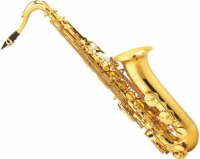








The saxophone is a family of woodwind instruments. Saxophones are usually made of brass and played with a single-reed mouthpiece similar to that of the clarinet.The saxophone family was invented by the Belgian instrument maker Adolphe Sax in 1840.Adolphe Sax wanted to create a group or series of instruments that would be the most powerful and vocal of the woodwinds, and the most adaptive of the brass that would fill the vacant middle ground between the two sections. He patented the saxophone on June 28, 1846, in two groups of seven instruments each. Each series consisted of instruments of various sizes in alternating transposition. The series pitched in B? and E?, designed for military bands, have proved extremely popular and most saxophones encountered today are from this series. Instruments from the so-called "orchestral" series, pitched in C and F, never gained a foothold, and the B? and E? instruments have now replaced the C and F instruments when the saxophone is used in the orchestra.
Invention History
Being the visionary he was, Adolphe had an idea to create a completely new instrument. This instrument would combine the power of a brass instrument with the subtleties of a woodwind instrument and the facility of a stringed instrument. After much experimentation, he had his first working model in 1841, which he called the bass horn. It wasn't until a review of his new instrument in the French paper Journal des Debats, however, that the name le saxophon or saxophone came about. In 1846, Adolphe Sax won two patents for his designs: One for a set of saxophones intended for the orchestra and the other for a set of saxophones intended for military bands. Each set consisted of a range of sizes from the small sopranino saxophone to the huge subcontrabass saxophone. These two patents represented Adolphe's two dreams for the saxophone.
The first dream was for the saxophone to become a key part of the orchestra. There were a few problems in the way of this dream. First was the fact that Adolphe over the years had made many enemies in the orchestral establishment. His constant desire to improve the mechanics of the wind instruments in the orchestra made many of the players grow angry with him, and his proud nature offended many conductors. Secondly, the saxophone, despite having a beautiful voice and great facility, lacked precise intonation at the time, and this made it problematic for the orchestra. Although the saxophone has been written for by a few orchestral composers, many of whom were personal friends of Adolphe, the saxophone to this day has not lived up to his dream of being a staple of the orchestra.
Adolphe's second dream, however, was realized on an even grander scale than he expected. Adolphe, although Belgian, had a special place in his heart for the French military bands. By definition, military bands are supposed to imbue a sense of power and confidence, but France's military bands in the mid 1800s sounded so weak that they instead invoked laughter. Adolphe believed that his instruments, especially his saxophones, could turn the image of the French military bands completely around. Reluctant at first, the French adopted his instruments. The result was so effective that military bands from around the world were knocking on Adolphe's door asking for his help, and his instruments.
This was a very important step for the saxophone because, through military bands, the saxophone would become a remarkable new image and sound that could be seen and heard around the globe. It was through these bands that the saxophone made its way to New Orleans and became a key component in the formation of early jazz.